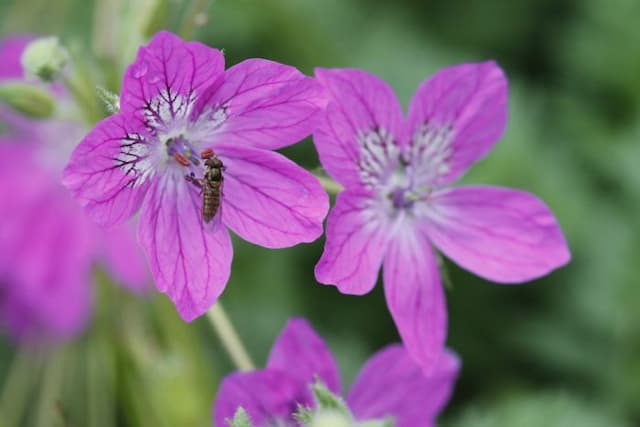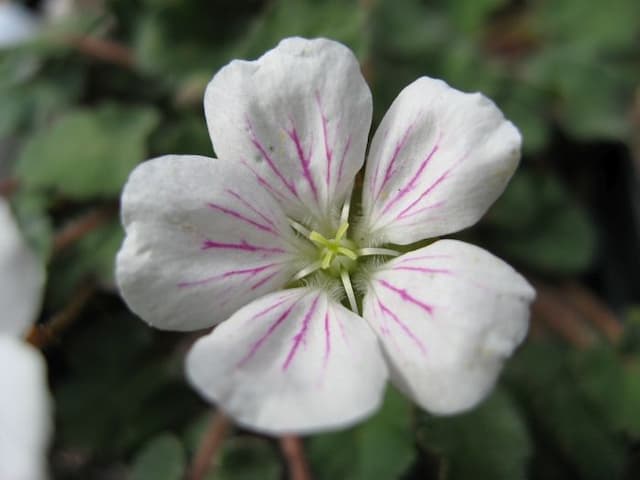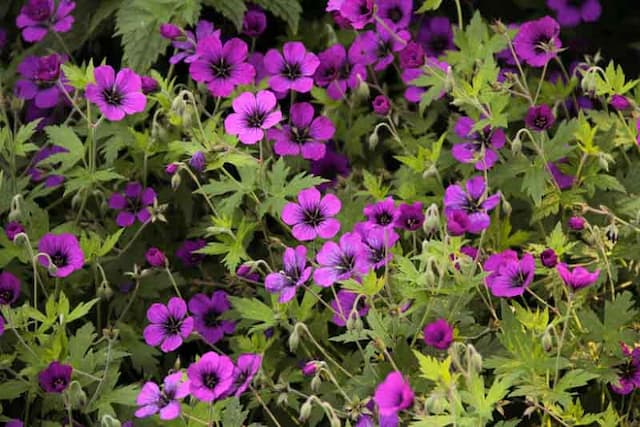Meadow Crane's-Bill 'Hocus Pocus' Geranium pratense 'Hocus Pocus'

ABOUT
A tall, yet compact herbaceous perennial growing to a height of 40cm. It has purple leaves and pale purple flowers with white veins and eye and blooms from June to September
About this plant
 Names
NamesSynonyms
Meadow Cranesbill, Hardy Geranium
Common names
Geranium pratense 'Hocus Pocus'.
 Characteristics
CharacteristicsLife cycle
Perennials
Foliage type
Deciduous
Color of leaves
Green
Flower color
Purple
Height
2-3 feet (60-90 cm)
Spread
1-2 feet (30-60 cm)
Plant type
Herb
Hardiness zones
4-8
Native area
Europe
Benefits
 General Benefits
General Benefits- Attracts Pollinators: Geranium pratense 'Hocus Pocus' is known to attract bees and butterflies, which are essential for pollinating plants.
- Aesthetic Appeal: With its attractive, deeply veined violet-blue flowers and dark foliage, this plant adds beauty to any garden space.
- Drought Tolerance: Once established, the Meadow Cranesbill, as it is commonly known, is quite tolerant to periods of drought, making it a good option for low-water gardens.
- Low Maintenance: This hardy perennial requires minimal care once established, making it an excellent choice for both novice and experienced gardeners.
- Versatile: It can be used in a variety of garden settings, including borders, wildflower gardens, and cottage gardens.
- Cold Hardy: Meadow Cranesbill is resilient in cold climates and can survive frost, making it suitable for gardens in cooler regions.
- Long Blooming: The plant has a long flowering season, often from late spring to early fall, providing lasting color in the garden.
- Deer Resistance: The plant is not a preferred choice for deer, which can help prevent damage to your garden from grazing.
- Soil Adaptability: It can adapt to a range of soil conditions, though it prefers well-drained soil, it can tolerate clay soil, dry soil, and varying pH levels.
- Spreads Easily: The Meadow Cranesbill can fill in garden spaces quickly as it spreads easily, making it beneficial for erosion control and covering bare spots.
 Medical Properties
Medical PropertiesThis plant is not used for medical purposes.
 Air-purifying Qualities
Air-purifying QualitiesThis plant is not specifically known for air purifying qualities.
 Other Uses
Other Uses- Textile Dyeing: The petals can be crushed to create a natural dye for fabrics, imparting a variety of soft blue and purple hues.
- Insect Repellent: The leaves of the Geranium can be rubbed on the skin as a mild natural insect repellent.
- Feline Deterrent: Gardeners may use the plant to help deter cats from entering garden areas as some cats dislike the scent.
- Eco-printing: Leaves and flowers can be used for eco-printing, a technique where plants are used to print images directly onto paper or fabric.
- Photography: The intricate details and rich colors of 'Hocus Pocus' make it a favorite subject for botanical photographers.
- Edible Flower Garnish: The petals are edible and can be used to adorn salads and desserts for an elegant presentation.
- Art Supplies: Children can use the petals and leaves as stamps or for creating patterns in art projects.
- Plant Markers: Sturdy stems of the Geranium can be repurposed as natural plant markers in vegetable gardens.
- Companion Planting: When planted in vegetable gardens, it can attract beneficial insects and may help to increase biodiversity.
- Floral Arrangements: The long-lasting flowers can be used in fresh cut arrangements for homes and events.
Interesting Facts
 Feng Shui
Feng ShuiThe Geranium is not used in Feng Shui practice.
 Zodiac Sign Compitability
Zodiac Sign CompitabilityThe Geranium is not used in astrology practice.
 Plant Symbolism
Plant Symbolism- Fertility - Geraniums are often associated with fertility due to their abundant and lush foliage.
- Health - With their medicinal properties and vibrant growth, geraniums symbolize a wish for good health.
- Friendship - The plant's long-lasting nature makes it a symbol of stable relationships and thus, friendship.
- Happiness - The bright and cheerful flowers of the geranium are often considered to represent happiness and positive emotions.
- Protection - Some cultures believe geraniums have the power to ward off evil spirits, symbolizing protection.
 Water
WaterThe Meadow Cranesbill, commonly known as Geranium pratense 'Hocus Pocus', should be watered thoroughly when the top inch of soil feels dry to the touch. This usually means watering approximately once a week, but frequency can vary depending on temperature and humidity. Aim to apply about 1 gallon of water per plant per watering session, ensuring that the water penetrates deeply into the soil to encourage strong root growth. During hot, dry spells, you may need to water more frequently. Be careful to avoid waterlogging as this can lead to root rot.
 Light
LightMeadow Cranesbill thrives in full sun to partial shade. The ideal spot would provide morning sunlight and afternoon shade, or dappled sunlight throughout the day. Avoid deep shade as it can reduce flowering and lead to leggy plants. Ample sunlight ensures healthy growth and abundant blossoms.
 Temperature
TemperatureMeadow Cranesbill can endure a wide range of temperatures but performs best when daytime temperatures are between 60 to 75 degrees Fahrenheit. It can survive temperatures as low as 20 degrees and as high as 85 degrees Fahrenheit. To ensure optimal growth and flowering, protect the plant from extreme heat by providing afternoon shade.
 Pruning
PruningTo promote bushier growth and more blooms, Meadow Cranesbill should be pruned in late winter or early spring. During the growing season, deadhead spent flowers regularly to encourage continued blooming. After the first flush of flowers diminishes, cut back the entire plant by about half to rejuvenate and encourage a second bloom.
 Cleaning
CleaningAs needed
 Soil
SoilMeadow Cranesbill thrives in moist, well-draining soil enriched with compost or organic matter. A pH between 5.8 and 6.5 is ideal for its growth. Blend equal parts of garden soil, compost, and perlite to ensure proper drainage and fertility.
 Repotting
RepottingMeadow Cranesbill typically does not require frequent repotting. Repot every 3 to 4 years in the spring to refresh the soil and provide room for growth, or when the plant outgrows its current container.
 Humidity & Misting
Humidity & MistingMeadow Cranesbill prefers average to slightly above average humidity levels. It does not have specific humidity requirements but benefits from the natural humidity found outdoors.
 Suitable locations
Suitable locationsIndoor
Ensure bright light and good air circulation.
Outdoor
Plant in partial shade, moist soil.
Hardiness zone
4-8 USDA
 Life cycle
Life cycleGeranium pratense 'Hocus Pocus', commonly known as Meadow Cranesbill or 'Hocus Pocus', begins its life as a seed that germinates in the spring when soil temperatures warm up. Seedlings emerge and develop into a rosette of basal leaves; during this vegetative stage, the plant focuses on root and foliage growth. In the late spring to early summer, 'Hocus Pocus' transitions to the flowering stage, producing striking deep violet-blue flowers that attract pollinators such as bees and butterflies. After pollination, the flowers develop into beaked seed capsules which split open to disperse seeds, completing the reproductive phase. Through summer and into fall, the plant continues to grow vegetatively while seeds are dispersing, ensuring new plants for the following year. Finally, in the winter, the above-ground part of the plant dies back, with the root system surviving underground to begin the cycle again in the spring.
 Propogation
PropogationPropogation time
Spring-Early Summer
Geranium pratense 'Hocus Pocus', commonly known as meadow cranesbill, is most commonly multiplied through division. This method involves separating the plant's clumps, typically in either spring or autumn when the plant is not in full bloom to avoid stressing the plant during its peak growth period. The process involves carefully lifting the plant from the soil, using a sharp knife or a spade to cut the clump into smaller sections, each with a portion of the root system and several shoots. These sections are then replanted into prepared soil, spaced about 12 to 24 inches apart (approximately 30 to 61 centimeters), and watered thoroughly to encourage root development. This technique allows for quick establishment and flowering, generally within the next growing season.









![Cranesbill [Rothbury Gem]](/_next/image?url=https%3A%2F%2Fplants-admin.emdemapps.com%2Fimages%2Fplants%2F%2Fimages%2F604b6243984c2.png&w=640&q=75)